Click on images to enlarge

infestation (Photo: Sheldon Navie)

habit (Photo: Sheldon Navie)
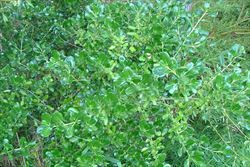
habit of female plant in fruit (Photo: Sheldon Navie)

male plant in flower (Photo: Sheldon Navie)
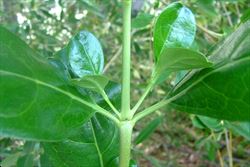
young stem and leaf bases (Photo: Sheldon Navie)
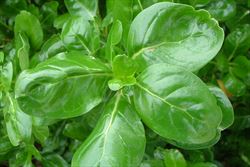
bright green glossy leaves (Photo: Sheldon Navie)
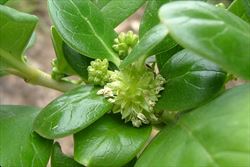
close-up of male flower clusters (Photo: Sheldon Navie)

female flowers and immature fruit (Photo: Jackie Miles and Max Campbell)

close-up of immature fruit (Photo: Sheldon Navie)
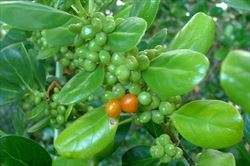
immature and mature fruit (Photo: Sheldon Navie)
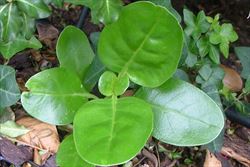
young plant (Photo: Sheldon Navie)
Scientific Name
Coprosma perpusilla subsp. subantarctica
Synonyms
Coprosma repens A. Rich.
Coprosma perpusilla Colenso subsp. subantarctica Orchard
Coprosma pumila Hook. f.
Family
Rubiaceae
Common Names
creeping mirror plant, creeping mirrorplant, looking glass bush, looking glass plant, looking-glass bush, looking-glass plant, mirror bush, mirror plant, mirrorplant, New Zealand laurel, New Zealand mirror bush, taupata
Origin
Native to New Zealand.
Cultivation
Commonly cultivated as a garden ornamental, or as a salt-tolerant windbreak, particularly in the temperate regions of southern Australia. Several cultivars with variegated leaves (e.g. Coprosma repens 'Variegata', Coprosma repens 'Picturata' and Coprosma repens 'Marble Queen') and horticultural hybrids are now more commonly seen in gardens.
Naturalised Distribution
This species is widely naturalised in southern Australia (i.e. in the coastal districts of southern and central New South Wales, in many parts of Victoria, in the coastal districts of south-eastern and southern South Australia, in Tasmania, and in the coastal districts of south-western Western Australia).
Also naturalised overseas in south-western USA (i.e. California).
Habitat
A weed of coastal environs (i.e. sand dunes and headlands), heathlands, open woodlands, closed forests, temperate rainforests, wetlands, roadsides, disturbed sites, old gardens and waste areas in temperate regions.
Habit
A spreading (i.e. prostrate to ascending) evergreen shrub or small tree growing 0.5-8 m tall, but usually less than 4 m in height.
Distinguishing Features
-
a spreading shrub or small tree usually less than 3 m tall.
-
its oppositely arranged leaves (2-8 cm long and 1-5 cm wide) are oval to rounded with bright green, glossy upper surfaces.
-
its inconspicuous greenish flowers are borne in clusters in the leaf forks.
-
separate male and female flowers are usually borne on separate plants.
-
its fleshy fruit (6-10 mm long) turn from glossy green to bright orange or red in colour as they mature.
Stems and Leaves
The stems become woody with age and turn greyish or brownish in colour. The younger branches are green or silvery-grey, relatively thick, and either hairless (i.e. glabrous) or somewhat hairy (i.e. pubescent).
The leaves (2-8 cm long and 1-5 cm wide) are oppositely arranged and are borne on short stalks (i.e. petioles) 5-16 mm long. They are oval (i.e. elliptic), oblong, rounded (i.e. orbicular) or broadly egg-shaped in outline (i.e. broadly ovate) and slightly fleshy (i.e. semi-succulent). These leaves have bright green and glossy upper surfaces and paler and duller green undersides. Their tips are rounded, flattened or slightly notched (i.e obtuse, truncate or emarginate apices) and they are hairless (i.e. glabrous). There are some small pits (i.e. domatia) present near the veins on the lower leaf surfaces.
Flowers and Fruit
The inconspicuous greenish or whitish flowers are borne in clusters in the leaf forks. Separate male and female (i.e. unisexual) flowers are usually borne on separate plants (i.e. this species is dioecious). The female (i.e. pistillate) flowers are tubular (about 3 mm long) and are usually arranged in three-flowered clusters. They have inconspicuous sepals (i.e. calyx minute) and four petals that are fused into a tube (i.e. corolla tube) about 3 mm long. This tube is topped with four small petal lobes (less than 3 mm long) and the female flowers also have a prominent style with two thick branches. The male flowers are arranged in dense clusers containing several flowers. They have inconspicuous sepals (i.e. calyx minute) and four petals that are fused into a tube (i.e. corolla tube) about 5 mm long. The tube is topped with four petal lobes (also about 5 mm long) and the male flowers also have four or five stamens. Flowering occurs mainly during spring and early summer (i.e. from September to December).
The fruit are fleshy (i.e. succulent) 'berries' (actually drupes) that turn from glossy green to bright orange or red in colour as they mature. These fruit (6-10 mm long) are egg-shaped (i.e. obovoid) with flattened or indented tips (i.e. truncate or depressed apices). They contain one or two seeds and are mainly present during late summer and autumn.
Reproduction and Dispersal
This species reproduces by seed and also vegetatively by rooting of the lower branches (i.e. layering). Th seeds are spread by birds and other animals and in dumped garden waste.
Environmental Impact
Mirror bush (Coprosma repens) is regarded as a significant environmental weed in Victoria and New South Wales and an environmental weed in Tasmania and South Australia. It is actively managed by community groups in Victoria, where it is most widespread, and is listed as a priority environmental weed in two Natural Resource Management regions.
This species particularly troublesome in coastal habitats, where it tolerates exposed sites such as sand dunes and rocky headlands. Infestations usually initially become established under trees where birds regularly perch. They then spread laterally and may eventually form dense clumps which impede the growth and regeneration of native plants. Mirror bush (Coprosma repens) has also invaded a number of other vegetation types in Victoria (e.g. dry coastal heathlands, freshwater wetlands, sclerophyll forests, rocky outcrops and even warm temperate rainforests).
Legislation
Not declared or considered noxious by any state government authorities.
Management
For information on the management of this species see the following resources:
- the Randwick City Council Environmental Weed Profile on this species, which is available online at http://www.randwick.nsw.gov.au.
Similar Species
Mirror bush (Coprosma repens) is very similar to karamu (Coprosma robusta) and the native coffee-berry (Coprosma hirtella). These species can be distinguished by the following differences:
- mirror bush (Coprosma repens) has slightly fleshy (i.e. semi-succulent) leaves with bright green and very glossy upper surfaces. There are some pits (i.e. domatia) present on the leaf undersides, where the side-veins join the central vein.
- karamu (Coprosma robusta) has leathery leaves with dark green and slightly glossy upper surfaces. There are no pits (i.e. domatia) on the leaf undersides
- coffee-berry (Coprosma hirtella) has leathery leaves with dark green and rough (i.e. scabrous) upper surfaces. There are no pits (i.e. domatia) on the leaf undersides.
It is also relatively similar to several other native coprosmas (Coprosma spp.). However, these native species have smaller leaves (usually less than 2 cm long) and their flowers are borne singly (i.e. they have solitary flowers).

